check engine CADILLAC DEVILLE 1996 7.G Service Manual
[x] Cancel search | Manufacturer: CADILLAC, Model Year: 1996, Model line: DEVILLE, Model: CADILLAC DEVILLE 1996 7.GPages: 354, PDF Size: 20.32 MB
Page 217 of 354
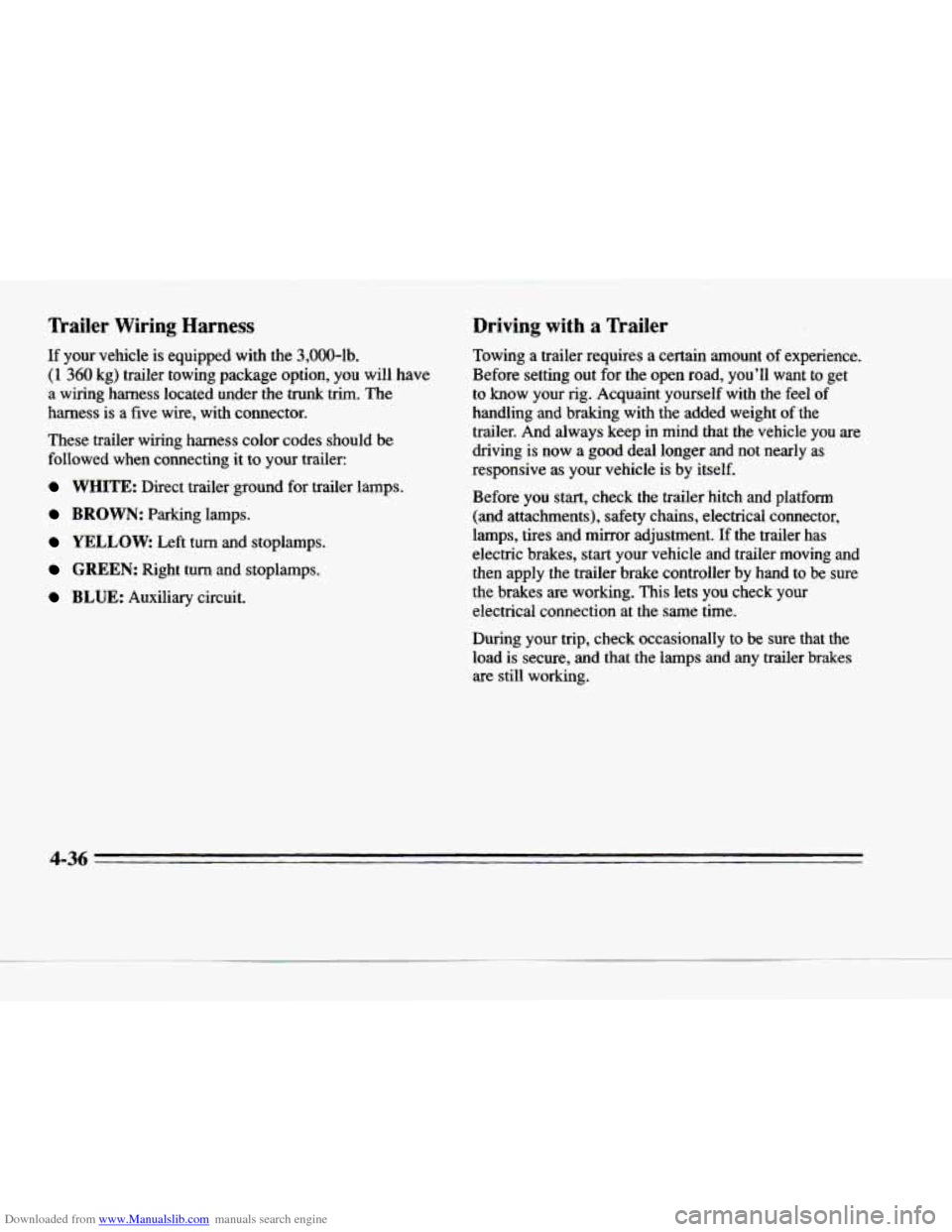
Downloaded from www.Manualslib.com manuals search engine nailer Wiring Harness
If your vehicle is equipped with the 3,000-lb.
(1 360 kg) trailer towing package option, you will have
a wiring harness located under the trunk
trim. The
harness is a five wire, with connector.
These trailer wiring harness color codes should be followed when connecting it to your trailer:
WHITE: Direct trailer ground for trailer lamps.
BROWN: Parking lamps.
YELLOW: Left turn and stoplamps.
GREEN: Right turn and stoplamps.
BLUE: Auxiliary circuit.
Driving with a Trailer
Towing a trailer requires a certain amount of expenence.
Before setting out
for the open road, you'll want to get
to know your
rig. Acquaint yourself with the feel of
handling and braking with the added weight of the
trailer.
And always keep in mind that the vehicle you are
driving is now a good deal longer and not nearly as
responsive
as your vehicle is by itself.
Before you start, check the trailer hitch and platform
(and attachments), safety chains, electrical connector,
lamps, tires and mirror adjustment. If the trailer has
electric brakes, start your vehicle and trailer moving and then apply the trailer brake controller
by hand to be sure
the brakes are working. This lets you check your
electrical connection at the same time.
During your trip, check occasionally to be sure that the
load
is secure, and that the lamps and any trailer brakes
are still working.
4-36
Page 219 of 354
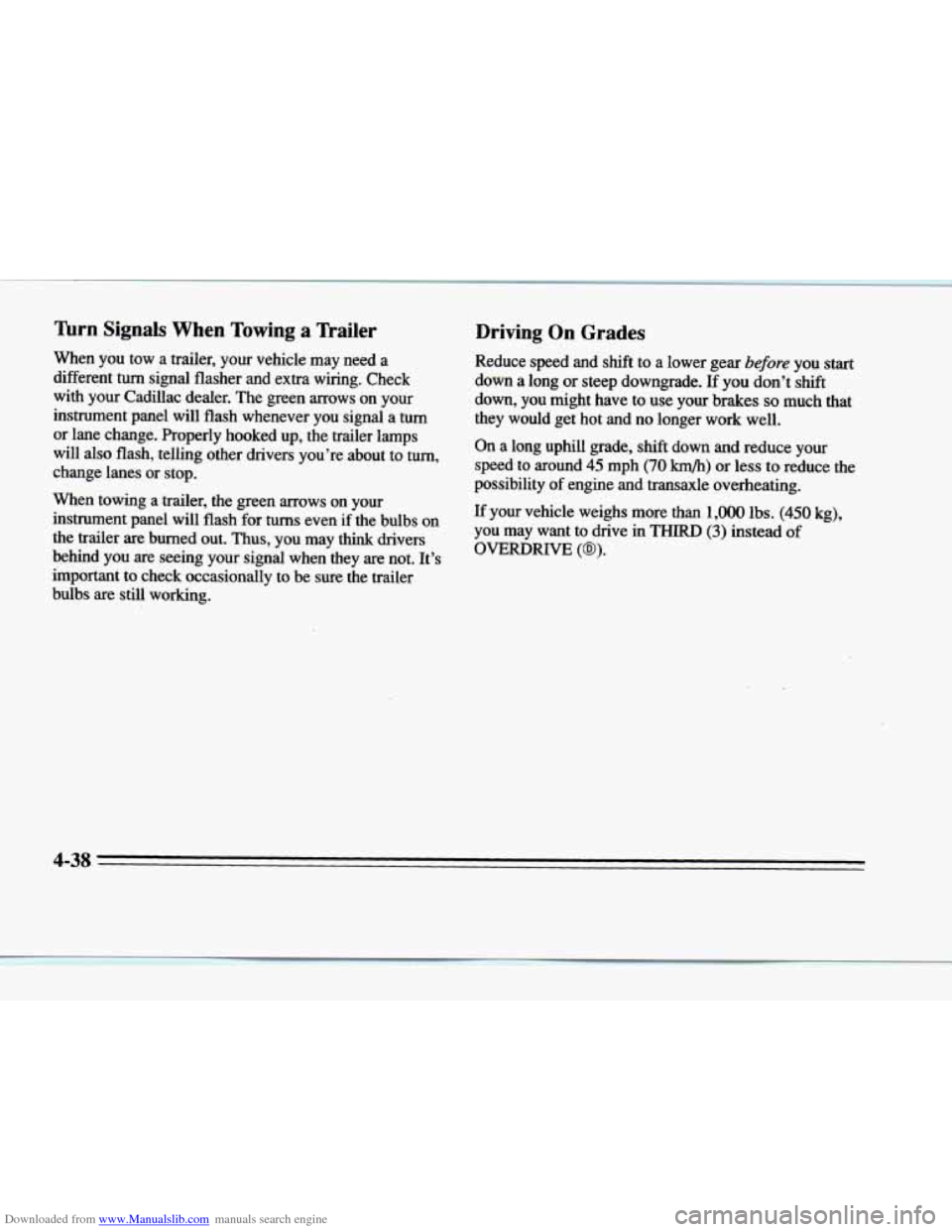
Downloaded from www.Manualslib.com manuals search engine lhrn Signals When Towing a nailer
When you tow a trailer, your vehicle may need a
different
turn signal flasher and extra wiring. Check
with your Cadillac dealer. The green
arrows on your
instrument panel will flash whenever you signal a
turn
or lane change. Properly hooked up, the trailer lamps
will
also flash, telling other drivers you’re about to turn,
change lanes or stop.
When towing a trailer, the green arrows on your
instrument panel will flash for turns even
if the bulbs on
the trailer
are burned out. Thus, you may think drivers
behind you are seeing your signal when they are not. It’s
important to check occasionally to be sure the trailer
bulbs are still working.
Driving On Grades
Reduce speed and shift to a lower gear before you start
down a long or steep downgrade.
I€ you don’t shift
down, you might have to use your
brakes so much that
they would get hot and no longer work well.
On a long uphill grade,
shift down and reduce your
speed to around
45 mph (70 b/h) or less to reduce the
possibility
of engine and transaxle overheating.
If your vehicle weighs more
than 1,OOO lbs. (450 kg),
you may want to drive in
THIRD (3) instead of
OVERDRIVE (@).
4-38
Page 221 of 354
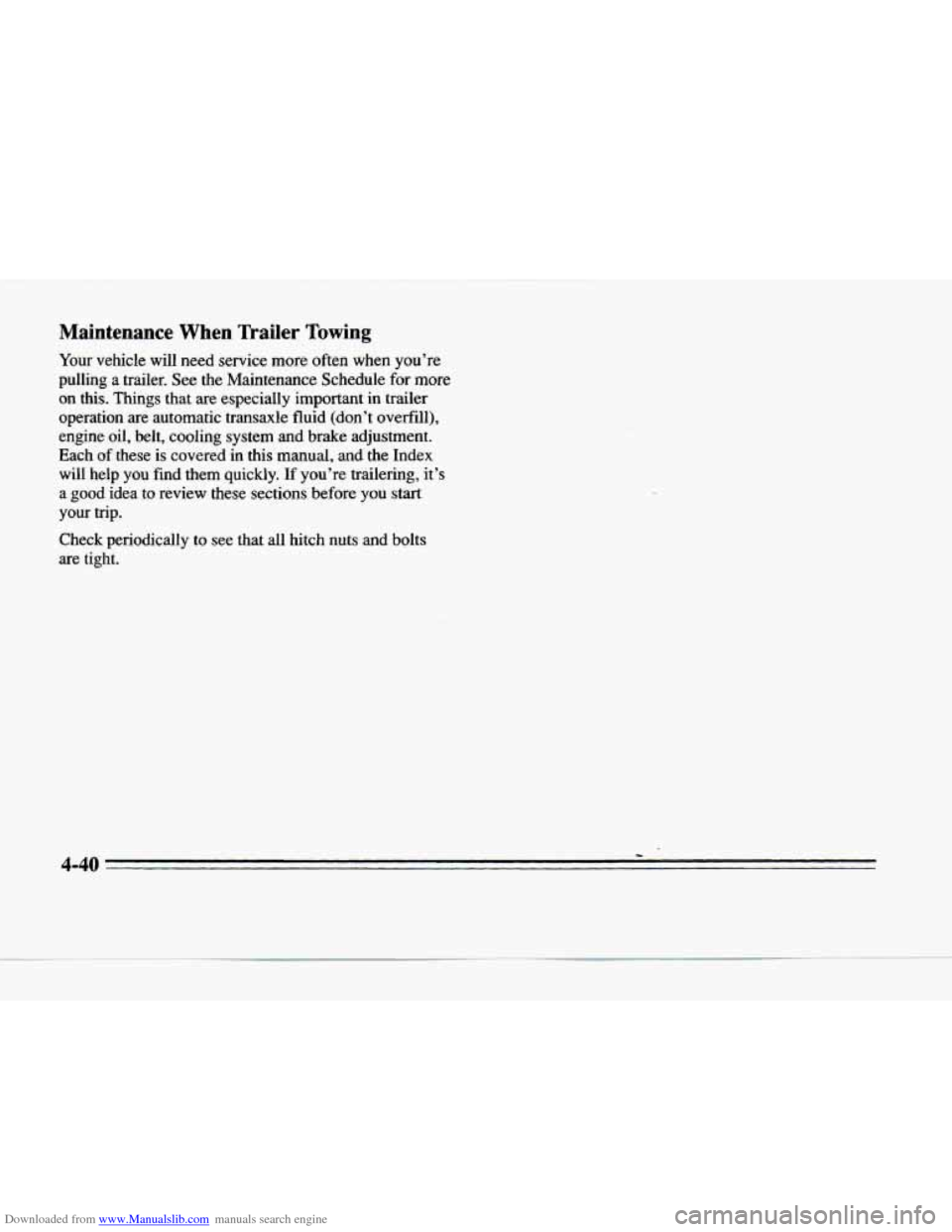
Downloaded from www.Manualslib.com manuals search engine Maintenance When Trailer Towing
Your vehicle will need service more often when you’re
pulling a trailer. See the Maintenance Schedule for more
on this. Things that are especially important in trailer
operation are automatic transaxle fluid (don’t overfill),
engine oil, belt, cooling system and brake adjustment.
Each
of these is covered in this manual, and the Index
will help you find them quickly.
If you’re trailering, it’s
a good idea to review these sections before you start
your trip.
Check periodically
to see that all hitch nuts and bolts
are tight.
-4
Page 226 of 354
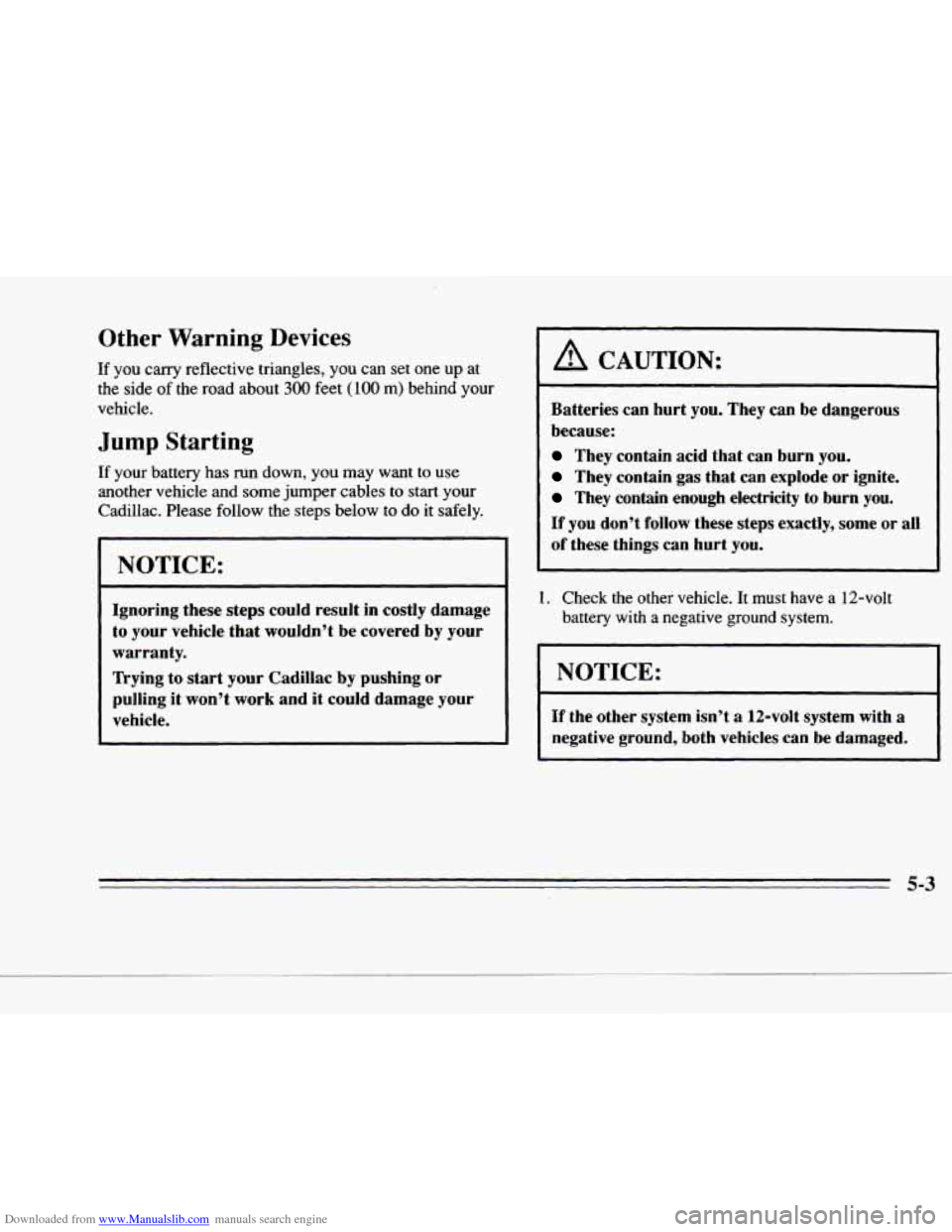
Downloaded from www.Manualslib.com manuals search engine c
P
e
Other Warning Devices
If you carry reflective triangles, you can set one up at
the side of the road about
300 feet (100 m) behind your
vehicle.
Jump Starting
If your battery has run down, you may want to use
another vehicle and some jumper cables
to start your
Cadillac. Please follow the steps below to do it safely.
NOTICE:
Ignoring these steps could result in costly damage
to your vehicle that wouldn’t be covered by your
warranty.
Trying to
start your Cadillac by pushing or
pulling it won’t work and it could damage your
vehicle.
A CAUTION:
Batteries can hurt you. They can be dangerous
because:
They contain acid that can burn you.
They contain gas that can explode or ignite.
They contain enough electricity to burn you.
If you don’t follow these steps exactly, some or all
of these things can hurt you.
1. Check the other vehicle. It must have a 12-volt
battery with a negative ground system.
I NOTICE: I
If the other system isn’t a 12-volt system with a
negative ground, both vehicles can be damaged.
5-3
Page 228 of 354
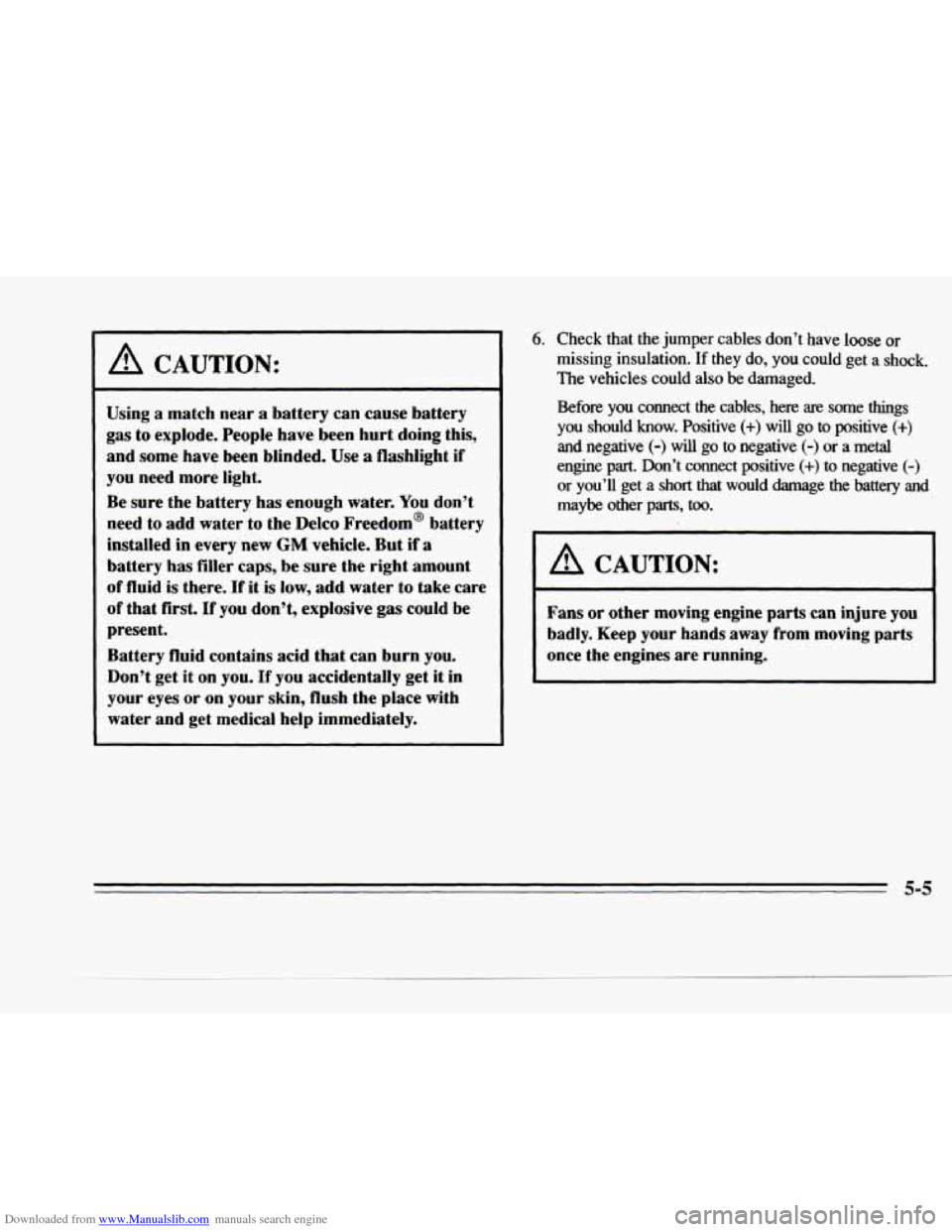
Downloaded from www.Manualslib.com manuals search engine c
LC.
A CAUTION:
Using a match near a battery can cause battery
gas to explode. People have been hurt doing this,
and
some have been blinded. Use a flashlight if
you need more light.
Be sure the battery has enough water. You don’t
need to add water to the Delco Freedom@ battery
installed in every new
GM vehicle. But if a
battery has filler caps, be sure the right amount
of fluid is there. If it is low, add water to take care
of that
first. If you don’t, explosive gas could be
present.
Battery fluid contains acid that can burn you.
Don’t get it on you.
If you accidentally get it in
your eyes
or on your skin, flush the place with
water and get medical help immediately.
6. Check that the jumper cables don’t have loose or
missing insulation. If they do, you could get a shock.
The vehicles could also be damaged.
Before you
connect the cables, here are some things
you should know. Positive (+) will go to positive (+)
and negative (0) will go to negative (-) or a metal
engine
part. Don’t connect positive (+) to negative (-)
or you’ll get a short that would damage the battery and
maybe other parts, too.
A CAUTION:
- - -~
Fans or other moving engine parts can injure you
badly. Keep your hands away from moving parts
once the engines are running.
5-5 c
Page 242 of 354
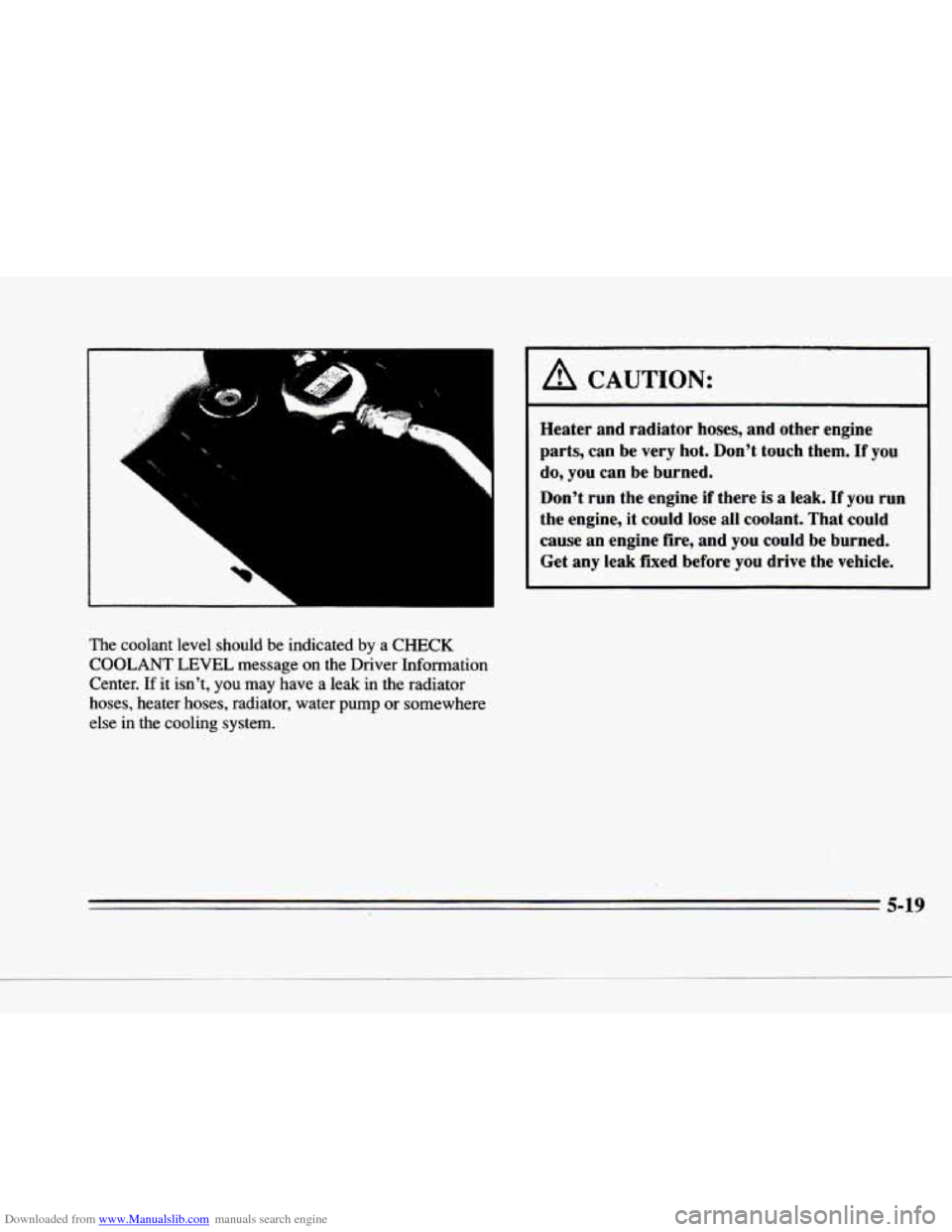
Downloaded from www.Manualslib.com manuals search engine F
c
7
a
The coolant level should be indicated by a CHECK
COOLANT LEVEL message on the Driver Information
Center.
If it isn't, you may have a leak in the radiator
hoses, heater
hoses, radiator, water pump or somewhere
else in the cooling system.
A CAUTION:
Heater and radiator hoses, and other engine
parts, can be very hot. Don't touch them.
If you
do, you can be burned.
Don't run the engine if there
is a leak. If you run
the engine,
it could lose all coolant. That could
cause an engine fire, and
you could be burned.
Get
any leak fixed before you drive the vehicle.
5-19
Page 243 of 354
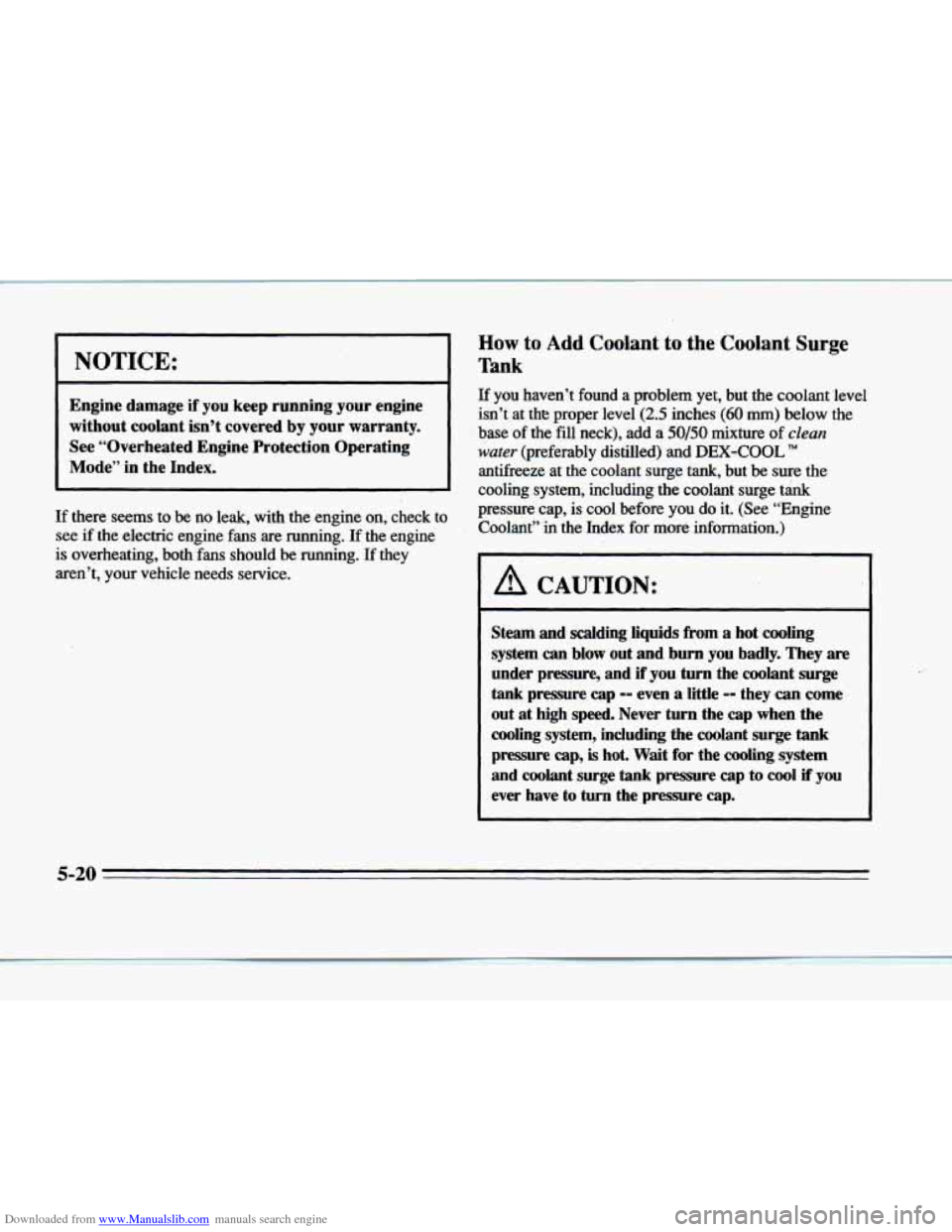
Downloaded from www.Manualslib.com manuals search engine I NOTICE:
Engine damage if you keep running your engine
without coolant isn’t covered
by your warranty.
See “Overheated Engine Protection Operating
Mode” in the Index.
If there seems to
be no leak, with the engine on, check to
see if the electric engine fans are running. If the engine
is overheating, both fans should
be running. If they
aren’t, your vehicle needs service.
How to Add Coolant to the Coolant Surge
Tank
If you haven? found a problem yet, but the coolant level
isn’t at
the proper level (2.5 inches (60 mm) below the
base
of the fill neck), add a 50/50 mixture of clean
water (preferably distilled) and DEX-COOL TM
antifreeze at the coolant surge tank, but be sure the
cooling system, including
the coolant surge tank
pressure cap, is cool before you do it. (See “Engine Coolant”
in the Index for more information.)
I A CAUTION:
Steam and scalding liquids from a hot cooling
system
can blow out and burn you badly. They are
under pressure, and if you turn the coolant surge
tank pressure cap -- even a little -- they can come
out at
high speed. Never turn the cap when the
cooling system, including the coolant surge tank
pressure cap,
is hot. Wait for the cooling system
and coolantsurge tank pressure cap to cool if you
ever
have to turn the pressure cap.
5-20
Page 247 of 354
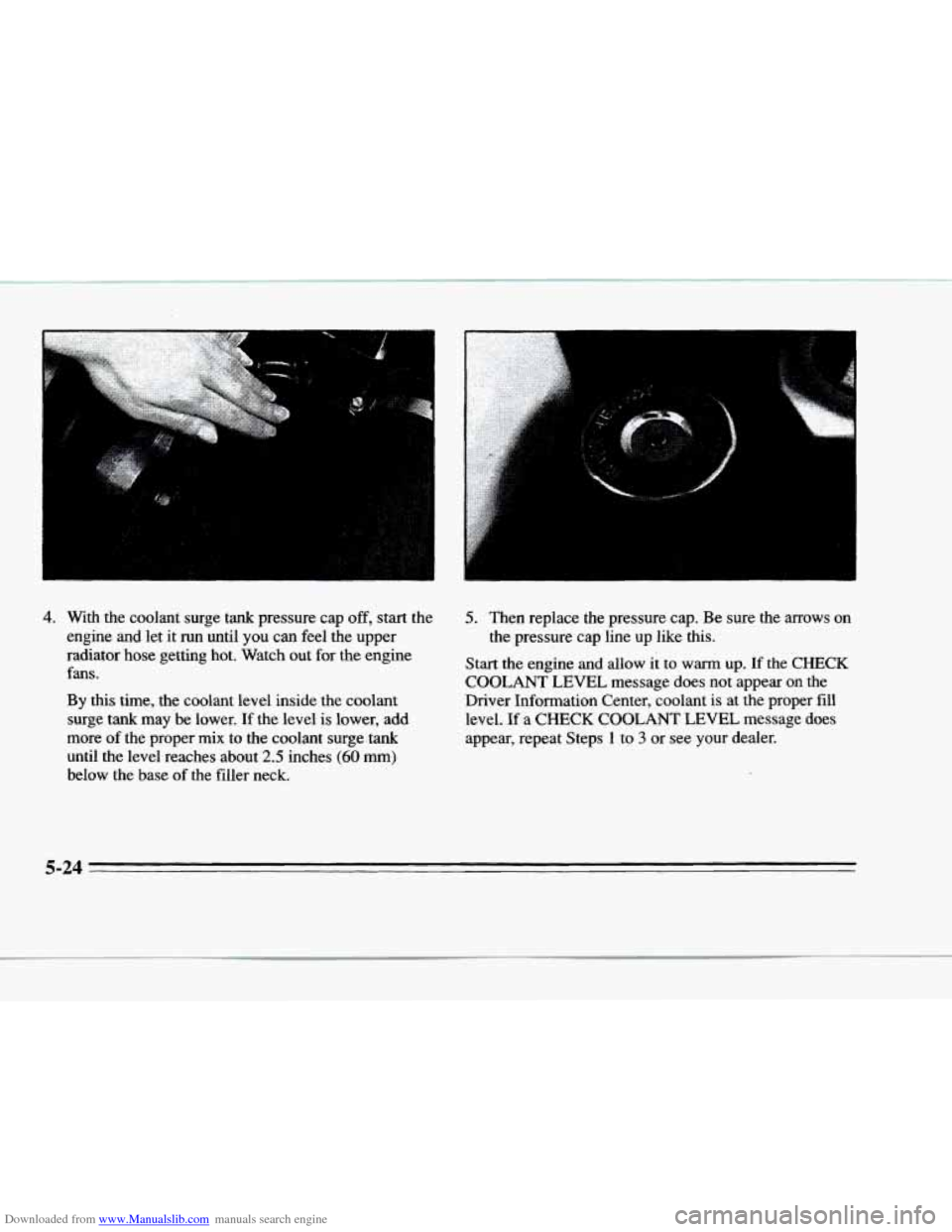
Downloaded from www.Manualslib.com manuals search engine k
4. With the coolant surge tank pressure cap off, start the
engine and let it run until
you can feel the upper
radiator hose getting hot. Watch out for the engine
fans.
By this time, the coolant level inside the coolant
surge tank may be lower.
If the level is lower, add
more
of the proper mix to the coolant surge tank
until the level reaches about
2.5 inches (60 mm)
below the base of the filler neck.
5. Then replace the pressure cap. Be sure the arrows on
the pressure cap line up like this.
Start
the engine and allow it to warm up. If the CHECK
COOLANT LEVEL message does not appear on the
Driver Information Center, coolant is at the proper fill
level.
If a CHECK COOLANT LEVEL message does
appear, repeat Steps 1 to
3 or see your dealer.
Page 258 of 354
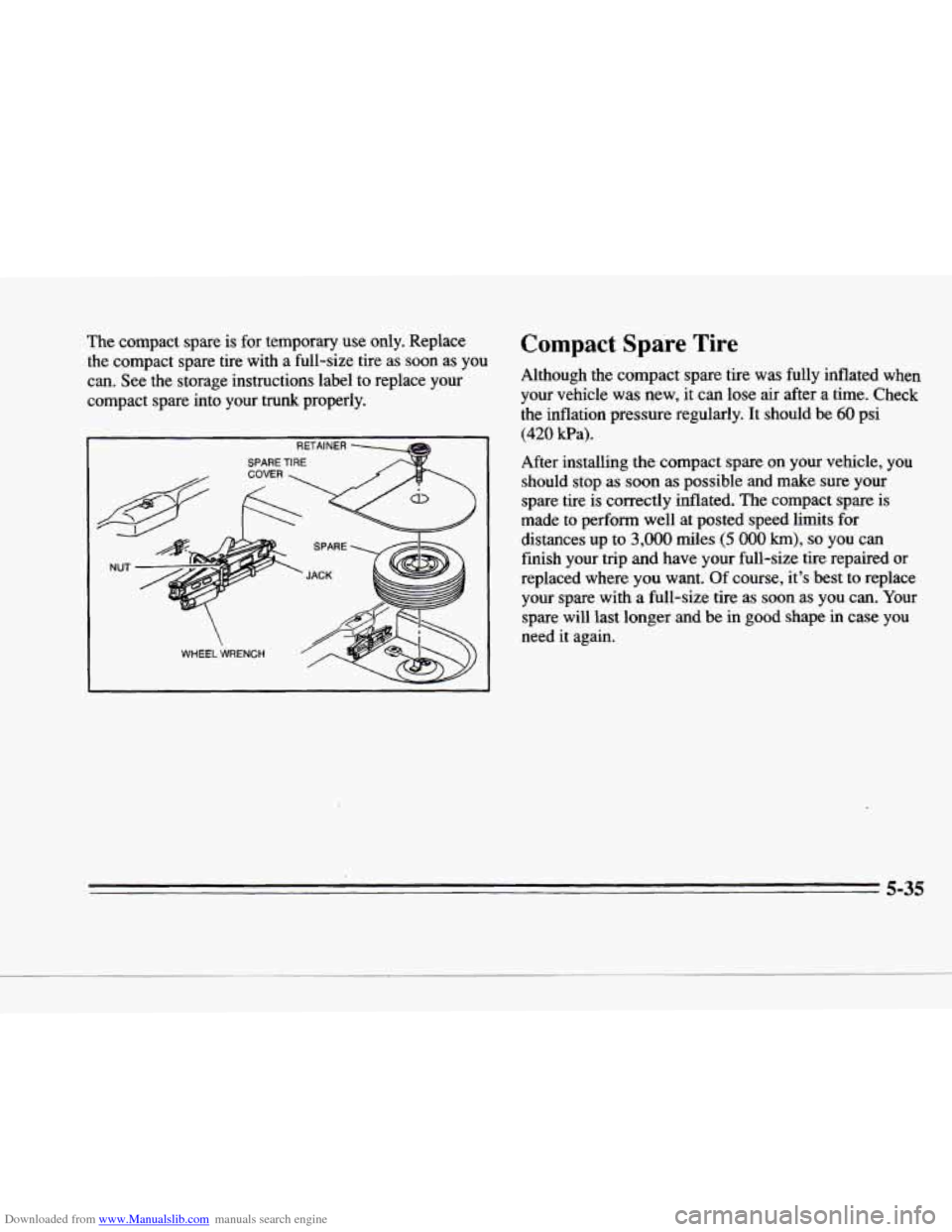
Downloaded from www.Manualslib.com manuals search engine .-
P
The compact spare is for temporary use only. Replace the compact spare tire with a full-size tire as
soon as you
can. See the storage instructions label to replace your
compact spare into your trunk properly.
Compact Spare Tire
Although the compact spare tire was fully inflated when
your vehtcle
was new, it can lose air after a time. Check
the inflation pressure regularly.
It should be 60 psi
(420 Wa).
After installing the compact spare on your vehicle, you
should stop
as soon as possible and make sure your
spare tire is correctly inflated. The compact spare is
made to perform well at posted speed limits for distances up to
3,000 miles (5 000 km), so you can
finish your trip and have your full-size tire repaired or
replaced where you want. Of course, it’s best to replace your spare with
a full-size tire as soon as you can. Your
spare will last longer and be in
good shape in case you
need it again.
5-35
Page 262 of 354
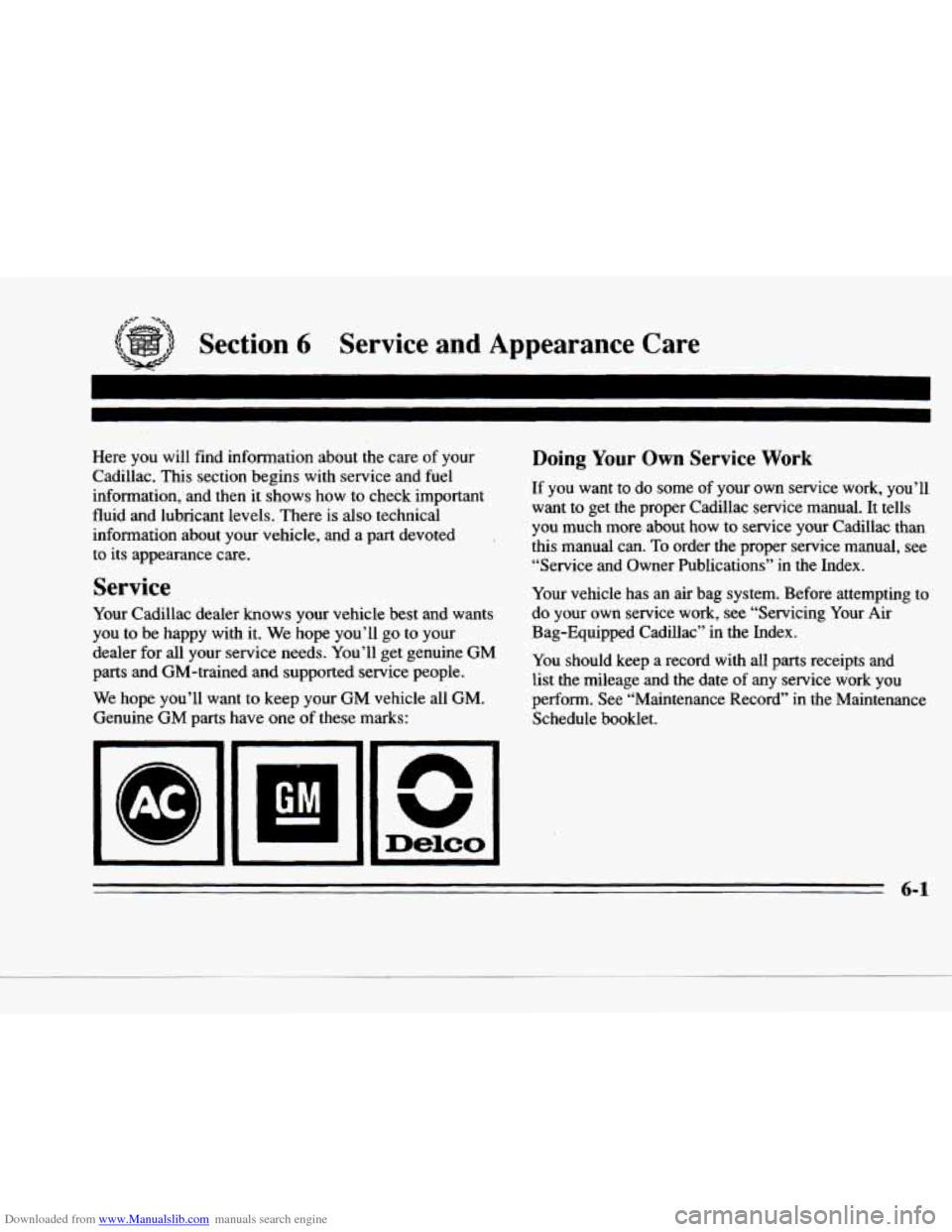
Downloaded from www.Manualslib.com manuals search engine c
Section 6 Service and Appearance Care
Here you will find information about the care of your
Cadillac. This section begins with service and fuel
information, and then it shows how to check important
fluid and lubricant levels. There is also technical
information about your vehicle, and a part devoted
to its appearance care.
Service
Your Cadillac dealer knows your vehicle best and wants
you
to be happy with it. We hope you’ll go to your
dealer €or all your service needs. You’ll get genuine GM \
parts
and GM-trained and supported service people.
We hope you’ll want to keep your GM vehicle all GM.
Genuine GM parts have one of these marks:
Doing Your Own Service Work
If you want to do some of your own service work, you’ll
want to get the proper Cadillac service manual. It tells
you much more about how to service your Cadillac
than
this manual can. To order the proper service manual, see
“Service and Owner Publications” in the Index.
Your vehicle has an air bag system. Before attempting to
do your own service work, see “Servicing Your Air
Bag-Equipped Cadillac” in the Index.
You should keep a record with all parts receipts and
list the mileage and the date
of any service work you
perform. See “Maintenance Record” in the Maintenance
Schedule booklet.
6-1